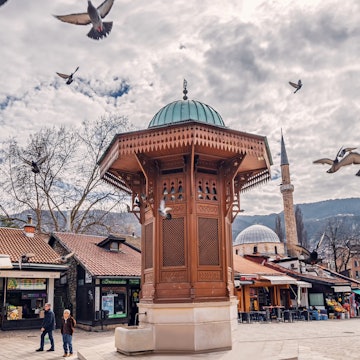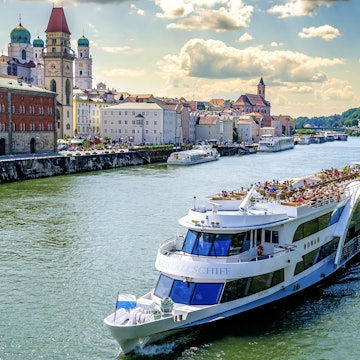
Highlights of western Serbia: Europe's little-visited winter wonderland
Oct 18, 2019 • 6 min read

Winter horse riding on the slopes of Zlatibor © courtesy of National Tourism Organisation of Serbia
With its icy temperatures, calorific cuisine and warming local rakija (plum brandy), Serbia makes for a wonderful European winter destination. Adventurous travellers should look beyond Belgrade and Novi Sad to the rural west of the country: a snow-clad region of virgin forests, lakes and river canyons, with affordable ski trails and chalets, and a heritage steam train that chugs through the mountainous landscape. It's good for film lovers too – filmmakers head there every January for Küstendorf International Film and Music Festival.

Chug through history on the Šargan Eight steam train
Step straight into history aboard the atmospheric, old-world Šargan Eight steam train, which takes you through tranquil snowy scenes across tall bridges and into tight tunnels. This narrow-gauge heritage railway was built as part of the line that originally connected Sarajevo to Belgrade during the years of the Yugoslav state. Today, the journey ends near Bosnia’s border. Pristine panoramas belie a tumultuous history in this strategic corner of the Balkans, which is brought to life in English over the train loudspeakers.
Across the border in Bosnia & Hercegovina, eye-catching Andrićgrad is a creation of award-winning film director Emir Kusturica. Conceived as a faux "old town", it was built in stone in Višegrad and its name is a nod to Ivo Andrić, the Nobel Prize-winning Yugoslav novelist. Višegrad is famous for its historic Unesco-listed Mehmet Paša Sokolović Bridge, described in Ivo Andrić’s epic novel The Bridge on the Drina.
Make it happen: Hop aboard Šargan Eight at Mokra Gora station. The ascent to Šargan Vitasi station costs 900RSD; check the winter schedule online. Andrićgrad is a 30-minute taxi ride (approximately €20) from Mokra Gora. Alternatively, buses (30 to 45 minutes) run between Mokra Gora and Višegrad; check the schedule online.

Hiking, riding and skiing in Serbia's winter playground
Western Serbia is a prime winter playground. Tara National Park comprises a densely forested massif of hiking trails, bound by the Drina River. Waterfalls, caves and traditional villages dot the rolling hills below the towering peaks of Mt Tara and Mt Zvijezda. You can hike along isolated snow-covered routes, stopping at viewpoints of deep gorges and azure waters.
In winter, Horse Riding Club Dora is based in Rača village, just above the national park’s 13th-century Rača monastery. Nearby Zlatibor's gentle slopes are also ideal for equestrians. Horse Farm Milinković (tel: 064 278 9066) and Zova Ranch (tel: 064 466 0129) offer horse-riding lessons and scenic rides on horseback or in hackney carriages.
Zlatibor is western Serbia's trendy ski spot. The tallest peak Tornik (elevation 1490m) hosts a popular ski centre, accommodating up to 5400 skiers per hour. It has 8km of pistes, a Nordic skiing trail, cross-country skiing and three ski lifts. The slopes are not particularly challenging, making them a good spot for beginners and kids. Non-skiers can enjoy the dazzling white valley scenery on well-marked mountain walking trails.
Make it happen: Hotel Zlatibor Mona, 7km from Tornik ski centre, is a good base. Ski-pass rates vary – a one-day pass costs around 1950RSD.

Sights of Tara National Park and beyond
Western Serbia’s outdoors hide some fascinating cultural sights. Inscribed on the Unesco World Heritage list, mystical stećci are medieval tombstones scattered across Bosnia and Montenegro as well as this part of Serbia. Within Tara National Park, look for two 15th-century necropolises in the villages of Perućac and Rastište; some of the intriguing reliefs include motifs of a circle, crescent or cross, and even a bow and arrow and two swords.
Further south, you can experience life in 19th-century Serbia at the open-air museum in the village of Sirogojno near Zlatibor. Quaint wooden houses spread on a hillside are a wonderful introduction to traditional rural life. Warm up in the small inn, and pick up some gorgeous locally made handicrafts or delicious natural produce in the souvenir shop.
Near the town of Užice, the grandiose Kadinjača memorial is a prime example of spomenik (Yugoslav-era memorial) architecture. Commemorating a legendary WWII battle and the fallen Partisans from the Workers' Battalion, the sprawling hilltop complex is a futuristic series of white granite monoliths, culminating in a symbolic "bullet hole" sculpture, and a stone pyramid with a crypt for the fallen fighters. Visiting in winter makes for an eerie experience.
Socialist-era monuments: exploring Belgrade’s stunning Spomeniks
Make it happen: Without your own wheels, you can arrange a tour through Tara Tours, with an office in Bajina Bašta, or Zlatibor Tours, based in Zlatibor. A return taxi to Kadinjača from Bajina Bašta should cost around 1300RSD; a return taxi from Zlatibor to Sirogojno will be about 3000RSD.
Calorific cuisine: western Serbia's best food
Feasts and local firewater are an essential element of western Serbia’s social spirit. Kurta restaurant in Tara National Park (which boasts Lady Gaga among its visitors in 2015) is known for locally produced ingredients. Meat-heavy menus include roast veal, medallions and smoked beef. Intensely sweet-savoury prunes in bacon are a speciality.
Seafood-lovers can gorge at Restoran Dve Lipe in Bajina Bašta, on the banks of the Drina. The popular local landmark, dating back to 1929, serves up traditional and affordable Serbian cuisine. Sampling the smoked trout is recommended.
In Zlatibor, head straight to Zlatiborska Konoba, for substantial meals such as the recommended venison stew, accompanied by live music from traditional tamburaši (mandolin-like instruments).
Calorific goodness comes in komplet lepinja (meaning "set bread"), which hails from the Zlatibor region. It’s a flat bun topped with roasted lamb or pork fat, considered the perfect fuel for winter skiing or the ideal hangover cure (needed after a night of drinking rakija). Klekovača is a twist on traditional plum or honey brandy, flavoured with juniper from Mt Tara. Živeli (cheers)!
Make it happen: Any of these restaurants can easily be visited on a sightseeing itinerary of the region. Buses run between the towns of Užice, Bajina Bašta (the gateway to Tara National Park) and Zlatibor; check the timetable online.

Filmmaker’s fairytale: Küstendorf Film Festival in January
Küstendorf Festival is held every January in the scenic Mokra Gora region about 200km from Belgrade. The stage is set, literally, on a snow-covered hilltop at Drvengrad wooden village. The village was built by film director Emir Kusturica for his film Life is a Miracle (2004), and he added chalet-style rooms (doubling as Hotel Mećavnik), restaurants, bars, cinemas and various quirky flourishes. At the festival, filmmakers from China to Iceland screen their new works for awards, while nightly concerts pulsate into the early hours.
Surrounded by wooded hills, Drvengrad makes a wonderful base for winter pastimes, free of big crowds. Traditional Serbian taverns are ubiquitous in the region, the heartland of rakija production (temperatures of -15°C offer the perfect excuse to sip this strong fruit brandy).
Make it happen: Airport transfers can be arranged from Belgrade through Hotel Mećavnik. The four-hour car journey is lined with conveniences.
Anisha Shah travelled to western Serbia with support from Küstendorf International Film and Music Festival. Lonely Planet contributors do not accept freebies in exchange for positive coverage.
Article first published in February 2016, and last updated by Brana Vladisavljevic in October 2019













